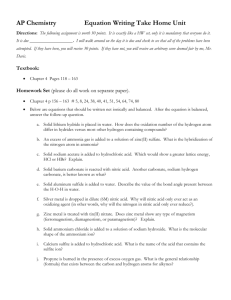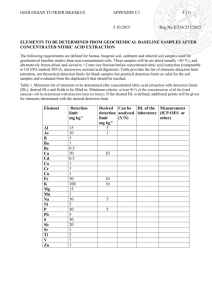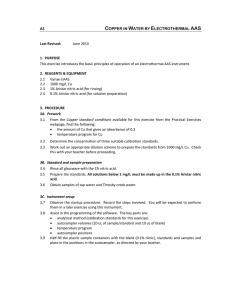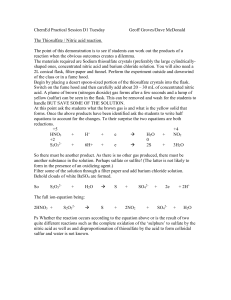Production of Nitric Acid
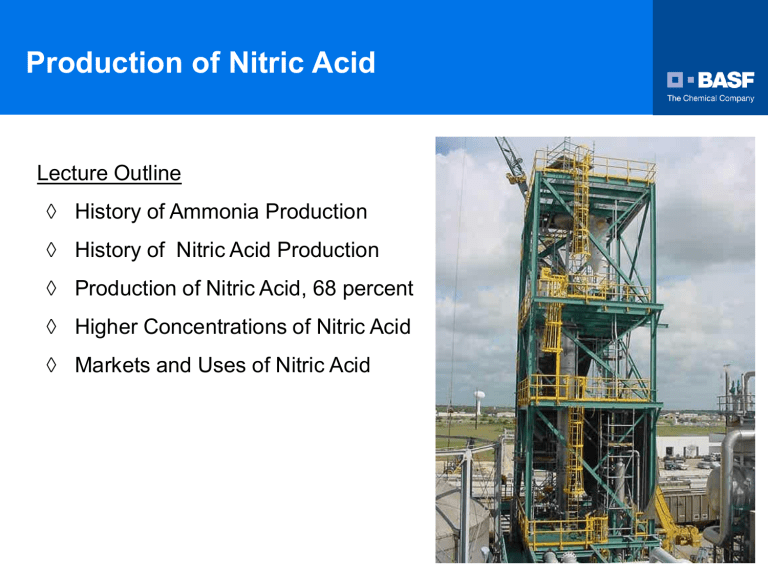
Production of Nitric Acid
Lecture Outline
History of Ammonia Production
History of Nitric Acid Production
Production of Nitric Acid, 68 percent
Higher Concentrations of Nitric Acid
Markets and Uses of Nitric Acid
History of Ammonia Production
Free ammonia was prepared for the first time in 1774 by J. Priestly and C.
Berthollet using ammonium carbonate
By the 1840’s, additional ammonia was recovered from coke oven plants and gas works as a by-product of the destructive distillation of coal.
Early 1900, American Cyanamid was formed. Producing calcium cyanamide from calcium carbide and nitrogen at 1000ºC.
About 1900 Fritz Haber began investigating the ammonia equilibrium reaction and evaluating effect of temperature. (Making ammonia from the elements)
In 1908 BASF and Haber entered into a agreement to work towards an industrial scale production plant.
Working with Karl Bosch’s group within BASF over the next 5 years the process was fully developed.
In 1913 the first commercial Plant was started in Ludwigshafen (30 tons per day).
NH3 Synthesis
F. Haber won the
1918 Noble Prize
In Chemistry for his work.
Drivers:
-Fertilizer
-Refrigerant
History of Nitric Acid Production
Nitric acid occurs in nature in the form of nitrate salts. Initially, large scale production of nitric acid began with sodium nitrate as a feed stock.
Near the beginning of the 20th century, world reserves of sodium nitrate were low and processes were being developed to replace nitrate with nitrogen.
Nitric acid was needed for explosives, munitions, and developing dyestuffs business
Three techniques were used industrially:
1) Production of NO by reacting N
2 and O
2 at greater that 2000 o C, abandoned because of poor energy efficiency.
2) Production of ammonia by hydrolysis of calcium cyanamide, not widely accepted.
3) Production of ammonia from N
2 and H
2
. (Haber-Bosch Process)
Fe
N
2
+ 3H
2
2NH
3
Production of Nitric Acid
The critical step in nitric acid production, the catalytic combustion of ammonia, was developed by Ostwald around the turn of the century and was in production by 1906.
The Ostwald Process
1) Catalytic Combustion
4NH
3
+ 5O
2
4NO + 6H
2
O
2) Oxidation of NO
2NO + O
2
2NO
2
N
2
O
4
3) Absorption
3NO 2 + H 2 O 2HNO 3 + NO
Ostwald Process
Production of Nitric Oxide
Catalytic Combustion
4NH 3 + 5O 2 4NO + 6H 2 O
The combustion of ammonia is one of the most efficient catalytic reactions with possible conversions up to 98 percent.
The catalyst is platinum and the reaction occurs at 900 o C. The catalyst is a
Pt-Rh fine-mesh gauze, where the Rh provides strength.
The biggest issue with this method is the loss of precious metal at the reactor temperatures.
Recovery gauze is typically used to absorb platinum oxide vapor and form an alloy. This gauze can periodically be removed and platinum recovered.
Burner Design
Burner Head
Platinum Gauze
Super Heater
Feedwater Preheater
Nitrous Gas Outlet
Production of Nitric Oxide
Catalytic Combustion
Production of Nitric Oxide
Catalytic Combustion
Burner Efficiency
Effect of Rh on the Platinum Gauze
Oxidation of Nitric Oxide
2NO + O 2 2NO 2 N 2 O 4
The NO is cooled en route to the absorption tower and, if necessary, compressed.
As a result of this process, part of the NO is oxidized to nitrogen dioxide and dinitrogen tetroxide.
To describe the kinetics of NO oxidation, a third-order rate equation is used.
This reaction is unusual because the reaction is quicker at lower temperatures. The reaction rate has a negative temperature coefficient.
Production of Nitric Acid
Absorption
3NO 2 + H 2 O 2HNO 3 + NO
Finally the gas is sent to an absorption tower, where it is crossexchanged with water.
The reaction model is quite complicated because of the number of components reacting (NO, NO 2 , N 2 O 3 , N 2 O 4 , etc)
Main Reactions:
N 2 O 4 + H 2 O HNO 2 + HNO 3
3HNO 2 HNO 3 + H 2 O + 2NO
Absorption of Nitric Oxides
Production of Nitric Acid
Absorption
3NO 2 + H 2 O 2HNO 3 + NO
The absorption tower is governed by the calculations for the oxidation process. Oxidation proceeds more slowly as the NOx concentration decreases in the top of the tower, therefore the spacing between the plates increase.
Acid formation takes place chiefly in the bottom third of the reactor, whereas NOx is reduced in the upper two thirds.
As a result, most of the heat of reaction is withdrawn in the lower third of the tower.
The coils on the upper plates work to keep the NO gas cool for fast reaction.
Absorption Tower
Process Diagram
Higher Concentrations of Nitric Acid
Nitric acid can be concentrated to about 68% in water with the above described process.
This concentration is adequate for most fertilizer applications but not for chemical nitration reactions.
However, there are ways to overcome the azeotrope (68% in water) and go to higher acid concentrations.
Concentrated Acid Processes:
1) Direct - injecting or absorbing NOx into weak nitric acid under pressure.
2) Indirect - extractive distillation and rectification with sulfuric acid or magnesium
Markets and Uses of Nitric Acid
The largest use of nitric acid is in the fertilizer industry, 74-78 percent
The second largest use is for manufacture of chemicals. Some examples are cyclohexanone, dinitrotoluene, and nitrobenzene
Finally explosives, metal nitrates, nitrocellulose, nitrochlorobenzene, a metal treatment solvent, rocket propellants, and nuclear fuel processing.
